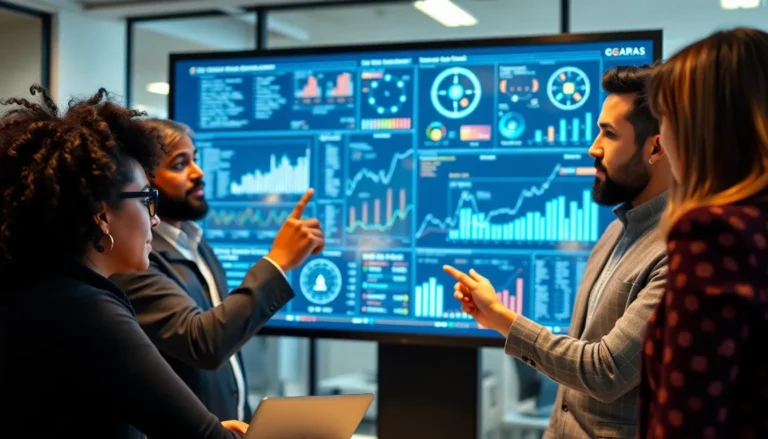Table of Contents
ToggleImagine a world where machines not only perform tasks but also crack jokes and understand your deepest secrets—well, sort of. Humanlike machines are stepping off the sci-fi movie screens and into reality, bringing a blend of innovation and a touch of humor to our daily lives. These robots are designed to mimic human behaviors, making them not just tools but potential companions.
Overview of Humanlike Machines
Humanlike machines represent a significant technological advancement, evolving from concepts in science fiction to tangible products in various sectors. Numerous companies invest in developing robots capable of mimicking human emotions and reactions. These machines benefit from sophisticated artificial intelligence algorithms that enhance their interaction capabilities.
Robotic features frequently include facial recognition, speech recognition, and natural language processing. These features enable seamless communication between humans and machines. Some humanlike machines, such as Sophia by Hanson Robotics, successfully convey emotions through facial expressions and body language.
Innovative designs often emphasize aesthetics. Many machines are crafted to resemble humans closely, enhancing comfort and relatability for users. Such familiarity makes humanlike machines suitable for applications in healthcare, education, and customer service.
Data shows that humanlike machines significantly improve user engagement. In healthcare settings, robots assist with elderly care, providing companionship and support. In educational environments, these machines serve as interactive learning tools, making lessons more engaging for students.
The integration of humanlike machines into daily life raises important ethical and social considerations. Discussions about privacy, the implications of human-robot relationships, and the potential for job displacement gain traction. As machines become more common, the importance of addressing these concerns continues to grow.
Research and development into humanlike machines progress rapidly. Emerging technologies hold the promise of even more advanced capabilities, including emotional intelligence, adaptability, and deeper conversational skills. As these machines evolve, they are likely to redefine human interaction with technology.
Types of Humanlike Machines
Humanlike machines come in various forms, each with unique features and functions that enhance human interaction and daily experiences.
Humanoid Robots
Humanoid robots resemble humans in appearance and behavior. They often possess articulated limbs, facial features, and expressions that facilitate emotional connections. Designed for diverse applications, these robots excel in social engagement, making them valuable in settings like museums, hospitality, and healthcare. Examples include Sophia by Hanson Robotics, which captures human-like expressions, and ASIMO by Honda, known for its mobility. Users find these robots more relatable due to their human-like traits. Data shows that humanoid robots significantly enhance user engagement and interaction in various environments.
Virtual Assistants
Virtual assistants operate primarily through software interfaces, using artificial intelligence to provide support. These programs function on smartphones, smart speakers, and other devices. Google Assistant and Amazon Alexa stand out as prominent examples, enabling users to perform tasks through natural language commands. Virtual assistants enhance productivity by managing schedules, answering queries, and controlling smart home devices. They create a seamless user experience by integrating into daily routines. Research shows that virtual assistants boost user efficiency and convenience, making them key components of modern technology.
Applications of Humanlike Machines
Humanlike machines are transforming various sectors, providing innovative solutions that enhance user experience. Their role in healthcare and customer service illustrates this evolution.
Healthcare Advancements
Healthcare settings increasingly integrate humanlike machines to enhance patient care. Robots assist in elderly care, providing companionship and monitoring vital signs. In rehabilitation, machines support therapy by guiding patients through exercises with real-time feedback. Data shows that these robots improve patient engagement, leading to better recovery outcomes. They often communicate using natural language, making interactions feel familiar and reassuring. Sophisticated AI algorithms allow these machines to adapt to individual needs, making healthcare more personalized. Furthermore, hospitals benefit from robots managing administrative tasks, freeing up staff for higher-priority care responsibilities.
Customer Service Enhancement
Humanlike machines significantly improve customer service efficiency. Many businesses employ robots in reception areas to greet visitors and assist with inquiries. These machines also handle routine customer questions, allowing human employees to concentrate on complex issues. Empirical evidence indicates that service robots increase response times and enhance customer satisfaction. Incorporating natural language processing enables seamless dialogue, creating personalized interactions. Companies like hotels and retail stores use these robots to provide a welcoming atmosphere while optimizing operations. Enhanced customer loyalty often results from positive experiences facilitated by humanlike machines in these environments.
Ethical Considerations
Humanlike machines raise several ethical concerns that deserve attention. Privacy often becomes a critical issue as these machines gather and store user data to function effectively. When individuals interact with robots, their personal information may be exposed, leading to potential misuse without proper safeguards.
Implications of human-robot relationships also warrant consideration. Users may develop emotional attachments to these machines, blurring the lines between companionship and genuine human interaction. This phenomenon can alter social behaviors and expectations, potentially impacting mental health and well-being.
Job displacement is another significant concern as humanlike machines automate tasks traditionally performed by humans. The integration of robots in various industries, especially in customer service and healthcare, can lead to reduced employment opportunities. As organizations adopt these technologies, it becomes crucial to address the need for reskilling and upskilling to prepare the workforce for future roles.
Regulations surrounding the development and deployment of humanlike machines must evolve alongside technology. Authorities need to establish frameworks that govern ethical practices in designing and implementing these robots. Transparency in their operations is essential for trust between humans and machines.
Moreover, the potential for bias in artificial intelligence algorithms presents another ethical challenge. If data used to train these systems reflect societal biases, humanlike machines could perpetuate and amplify these issues. Ensuring fairness and inclusivity within AI systems must become a priority for developers.
Societal perceptions of humanlike machines vary widely. While many view them as beneficial innovations, others express concerns about their impact on human interaction. Engaging in open dialogues about these technologies can foster understanding and guide responsible development. Prioritizing ethical considerations during the progression of humanlike machines ensures technology remains a force for good in society.
Future of Humanlike Machines
Emerging technologies forecast a promising future for humanlike machines, enhancing their capabilities in various sectors. Companies continue to invest heavily in this field, aiming to create robots that interact seamlessly with humans. Sophisticated artificial intelligence algorithms enable these robots to mimic emotions and respond to social cues effectively.
Research shows that improvements in emotional intelligence and conversational skills will likely redefine interaction dynamics. Anticipated advancements in natural language processing will facilitate even deeper, more meaningful connections between humans and machines. Companies such as Hanson Robotics and Honda are already leading the way with humanoid robots like Sophia and ASIMO.
Applications across different domains demonstrate the transformative potential of these machines. In healthcare, for instance, robots provide companionship, monitor patient wellness, and support rehabilitation exercises. Customer service also benefits through enhanced efficiency, as robots manage routine inquiries and allow human staff to focus on complex tasks, thus improving overall user satisfaction.
Ethical concerns must be addressed as integration advances. Privacy issues arise with the potential for data misuse, highlighting the need for stringent regulations. Societal perceptions show a dichotomy; while some embrace these technologies as beneficial, others voice concerns over emotional attachments and job displacement. Ongoing dialogues about the ethical use of humanlike machines are vital for fostering understanding and responsible development.
Optimism surrounds the future of humanlike machines, expected to become integral components of everyday life. Practical applications will evolve, enhancing user experiences and sustaining growth. Overall, the trajectory indicates that humanlike machines will play a significant role in shaping interactions in a technologically-driven world.
Humanlike machines are poised to redefine the landscape of technology and human interaction. As they evolve with advanced capabilities in emotional intelligence and communication, their presence in everyday life will likely become more pronounced.
While these innovations promise enhanced user experiences and improved efficiency across various sectors, they also bring forth critical ethical considerations. Addressing privacy concerns and the implications of human-robot relationships will be essential in fostering trust and transparency.
Engaging in ongoing discussions about the responsible development of these technologies will ensure they serve as beneficial companions rather than sources of anxiety. The future of humanlike machines holds immense potential, and navigating this journey thoughtfully will be key to maximizing their positive impact on society.







